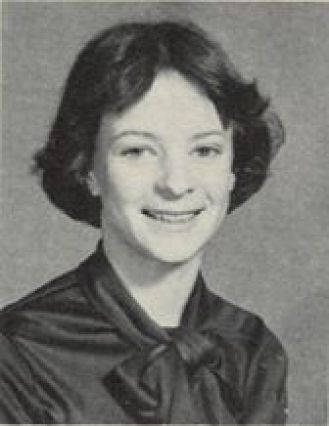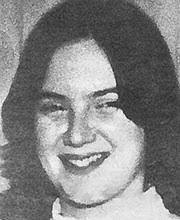Folie à deux
This year my posts will be a little more episodic and random. I’ve distilled down some stories I’ve heard or read about over the years, and I’ll be reporting out on the best stuff. It’s like dumpster-diving except you don’t have to do it; I’ve sifted through the crap and pulled out all the good stuff for you. That means not everything will have a neat conclusion. Last time we talked about some bikers who recovered a safe in an old plane. What was in the safe? What does it mean? I don’t know. As Pepe says in the most-excellent Ernst Lubitsch film, The Shop Around The Corner, “Draw your own conclusions.”
 Theresa Allore – high school yearbook photo 1976
Theresa Allore – high school yearbook photo 1976There’s an even more frightening theory than the one where it’s “statistically improbable” that a serial killed didn’t commit three similar murders in the space of 19 months in the Eastern Townships: the idea that all sorts of people were getting away with some very bad things, including murder in the era of my sister Theresa’s murder. One of the ideas that has persisted over the years is the theory of a folie-a-deux; more than one offender committing these murders, as a shared, escalating experience with one partner being more dominant, possibly older than the other.
The classic folie a deux can be seen in the Papin sisters, two maids who murdered their employer in Le Mans, France (1933). The case became the subject of Jean Genet’s play, The Maids. An American variation is the murder of a 14-year-old boy by two University of Chicago students, Leopold and Loeb. They did it for kicks, just to prove to themselves that they could get away with it as a sort of right of passage, not unlike what we know of biker gang initiations. It’s never entirely clear which of the partners is in control, but there is always a sense of one dominating the other and egging them on in a shared psychosis. You recognize this relationship from many Alfred Hitchcock films like Rope and Strangers on a Train. The one folie a deux we’ve talked about most recently is the case of the twin New York Gynecologists, Stewart and Cyril Marcus. In this affair, their drug addiction moved them to symbiotic self-destruction and suicide, as represented in the David Cronenberg film, Dead Ringers.
 The Papin sisters, Christine (in foreground) and Léa (behind), arrive at their trial in September 1933. Photograph: Keystone-France/Gamma-Keystone via Getty Images
The Papin sisters, Christine (in foreground) and Léa (behind), arrive at their trial in September 1933. Photograph: Keystone-France/Gamma-Keystone via Getty ImagesThe folie a deux theory was introduced to me very early in investigating my sister’s case. Shortly after the publication of the Who Killed Theresa stories in The National Post in 2002, a woman came forward with a strange tale. At first glance it appeared unrelated, but she felt it might have been connected to the Township murders of Theresa Allore, Manon Dube and Louise Camirand.
In the summer of 1976 this woman was a teenager hitchhiking with a friend along Sherbrooke St. in Montreal’s East End, They were headed in the direction of what today is CFB Longue Pointe, which is just before the intersection with Route 25. They were picked up immediately by two men, a younger man with a “military haircut” who was driving, and an older man riding in the passenger seat dressed in a suit with greased-back hair. The girls climbed in the back of this “brown American car with construction rags hanging out of the trunk”. Almost immediately the older man reached in the back of the car, knocked the girls’ heads together, and began beating them. He told them they were going to die, at which point one of the girls stuck her cigarette in his cheek. The two girls jumped from the moving vehicle (shades of Peggy Coleman here) and tried to hide in a nearby field. The vehicle returned and attempted to run them over before racing off into the night.
This horrifying account captures the imagination because it contains elements that hint at narrative threads in the Allore-Dube-Camirand story. There is the young man with the military haircut in a car going in the direction of the Montreal Canadian Forces Base. We know that in the summer of 1976 – the summer of the Montreal Olympics – cadets from the Sherbrooke Hussars were sent to Montreal to work at the Longue-Pointe base, building lockers and generally making themselves busy in preparation for the games.
 Sherbrooke Hussars work the Montreal Olympic Games – 1976
Sherbrooke Hussars work the Montreal Olympic Games – 1976Luc Gregoire may have been one of those cadets with the Sherbrooke Hussars ( we definitely know that Louise Camirand worked at the Hassars compound in Sherbrooke). Is it possible that Luc Gregoire was the young man at the wheel of the car in this 1976 Montreal attack? One of the reasons a folie a deux is so compelling in the case of Luc Gregoire is it helps to justify one of the major obstacles in a theory of him being the murderer of Allore-Dube-Camirand: his age. In 1976 Luc Gregoire would have been 16; the right age to be off on a summer in Montreal doing cadet training, but is it the right age for a murderer?
If the theory holds, Gregoire was just 17 when he committed the brutal sexual assault, mutilation and strangulation murder of Louise Camirand. Not impossible. I would remind you that Richard Bouillon – long suspected in the disappearance of Julie Surprenant, in a death bed confession he admitted to her murder – raped dozens on girls before the age of sixteen. But the probability is elevated if we consider that Gregoire may have been groomed and tutored at the hands of an older, more experienced offender.
So if this is Gregoire in 1976 – and I don’t think it is, we are just doing an exercise here – then who is the older, greasy guy? Someone once suggested that it might have been Jean-Luc Pouliot, the patriarch of the Pouliot clan thought to have orchestrated the shotgun murders committed in Compton in 1984. It’s an interesting idea. Compton is where Theresa was found, the Pouliots had a cottage on Lake Memphremagog near where the body of Louise Camirand was found. But it’s really a case of cherry-picking people to fit the information. We know Gregoire and Pouliot because I have discussed them at length, so now we put them together, because these are the offenders we know. I can tell you there were hundreds of older and younger offender combinations in the Eastern Townships in that era who you could equally consider as possible suspects in a folie a deux.
 Jean-Luc Pouliot
Jean-Luc PouliotI will leave you with one further thought before we move on: Although I do not think that Gregoire and Pouliot were the pair in the 1976 Montreal folie a deux, simply by introducing that possibility allows for the idea to capture your imagination.




Perhaps a better approach would be to look at some of the cases we’ve covered from the ’70s and consider which of them may have been committed by more than one person. Sharron Prior from Montreal in 1975 seems like a case of more than one offender. It’s believed she was held captive for a number of days before being dumped in Longueuil. Louise Camirand is very similar. The dump site near Magog is not the site of her torture and murder. In both cases, police have always held out the possibility of more than one person committing the murders. Jocelyne Houle, who disappeared on a night out in Montreal (last seen at the Old Munich), appears to have been a gang-rape killing ( she was dumped in Sainte Calixte where many bikers lived, and were known to dump bodies).
If we look at the following table, we can sort some of the cases into two groups. These are not all of the cases; if I’ve left some out it’s because I’m undecided which category the fall under. But when you consider these two groupings, something else in common becomes apparent:
Single OffenderMore than one offenderKatherine HawkesSharron PriorLison BlaisLouise CamirandNicole GaudreaultJocelyne HouleTheresa AlloreThe single offender groupings (Hawkes, Blais, Gaudreault) are all urban murders. The more-than-one-offender groupings are all rural. Considering this, I would say it’s easier for one person to commit murder in a city. The work can be done undetected. You can be on your way to a bus or metro rather quickly. It also implies something of the motive: perhaps a purse snatch that escalates. Or a purse snatch that is the initial justification to mask a crime of a more sexual nature. The group murders suggest something else: the joyride, the gang-bang, something for kicks, because women are expendable. But let’s not get too attached to these distinctions. Remember that Guy Croteau acted alone when he picked up Sophie Landry at a Longueuil bus station in 1987, stabbed her 173 times, and dumped her in a corn field north of Montreal.
 Compton Station look toward Compton, Quebec
Compton Station look toward Compton, QuebecWhy might Theresa Allore be a matter of a folie a deux? I’m slightly embarrassed to admit this but in the early 2000s I consulted a psychic, Laurie Campbell, known from the book, The Afterlife Experiments. She described Theresa being picked up just outside of her King’s Hall residence in Compton, at the mailbox actually. There was a large car with more than one person in it, and she was persuaded to get in the vehicle. That’s just information, it’s not evidentiary, and I’ve sat on it for a while.
The more compelling reason is because that’s what the evidence tells us. We know she was last seen in Lennoxville. We know she wanted to get to her residence 10 miles away in Compton. We know there was no bus service and she didn’t have a car. And we know she was prone to hitchhiking.
We also know that over the years, there have been several first-hand reports of horror-show hitchhiking experiences along the Lennoxville – Compton corridor that ended in sexual assaults or attempted assaults – most notably the account of Catherine Dawe who was orally raped in the parking lot of King’s Hall in 1977.
Finally this: We know that shortly after the publication of Wish You Were Here, the Quebec police received a phone call from a witness documenting something they observed in the fall of 1978. The Surete du Quebec consider this account very credible. The person was driving in the area of Lennoxville – Compton in the fall of 1978. They observed a vehicle with three individuals inside chasing a young woman who was running down the road.
That too is just information. And now that terrifying idea is out of my head and into yours.
The post Folie à deux first appeared on Who Killed Theresa?.



